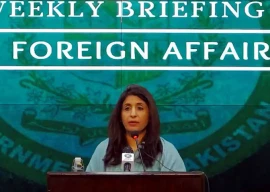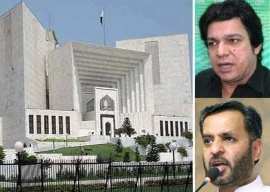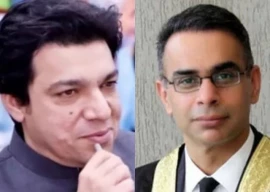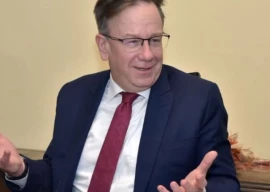The building was established on November 18, 1913 and even today churchgoers gather here every Sunday for Mass. Churches such as this one are hidden away in almost every corner of the Islamic Republic of Pakistan, often mistaken for the mosques that they stand alongside or overlooked altogether.
On Monday, the Deputy British High Commission launched a thick burgundy book bearing a crisp picture of a wood-panelled St Mathews church in Nathia Gali, titled ‘Churches of Pakistan’. The book is a compilation of photographs of Pakistan’s Christians through their architecture by Dr Safdar Ali Shah and Syed Javaid A. Kazi.
It includes an invaluable chapter on the history of the Church in Pakistan “This [book] is a tribute to Pakistani Christians who have done so much for the country yet many of whom remain unsung and unremembered,” said Paramount Publishing Enterprise chief executive officer Iqbal Saleh Muhammad.
No building has been overlooked - alongside majestic red-brick structures such as the Cathedral of the Sacred Heart of Jesus, Lahore, are snapshots of diminutive brick structures bearing steeples.
For Christians and Muslims alike, these structures are part of their heritage. Asif Noorani, a former St Paul’s student and now a well known art and culture critic, reminisced about St Patrick Cathedral’s interconnecting passages that he used to sneak through to pass St Joseph’s Convent High School in Saddar, Karachi as a school boy. “The St Patrick’s church is absolutely sublime,” he mused nostalgically. “I have never seen anything as exquisite as it, even in Bombay which is home to some beautiful churches.”
His passion, when speaking of the All Saints’ Church in Peshawar, was infectious. Built in 1883, the church inside the Kohati Gate of the city looks strikingly like a mosque. “If it were not for the cross on top of the building, people would assume it was a mosque because of the minarets and dome-shaped architecture. Even the Bible scriptures are carved in Persian and Pashtu.”
On a personal note, the chairman of the Higher Education Commission, Javed Leghari, spoke of how he recently visited Nathia Gali for the first time. “I had heard about this church [pictured on the cover of the book],” he said. “So when I visited Nathia Gali, I made it a point to go see it. Just the chance to see that church in person made the entire trip worthwhile.”
Leghari said he hoped the book would be marketed worldwide so people would get an opportunity to see the “real face of Pakistan”. “We have also recently allocated a space to build a church at the University of Agriculture, Faisalabad,” he added.
“I have visited many churches but it was great to get an opportunity to see the ones I haven’t,” said Sister Julie Pachecho, the principal of St Joesph’s Convent High School. “It is also interesting to see how others have projected it, and not just what we see through our eyes.”
There was an edge of desperation hidden in all the speeches and comments. Almost as if the gathering was anxious for society to make space and show compassion for one of the oldest faiths in South Asia. “The presence of the faith [Christianity] here is not a recent phenomenon,” stressed the country director for the British Council, David Martin. “The roots of Christianity in the area go back to the very origins of the religion. In fact, Christianity came to South Asia perhaps even earlier than [it did to] remote parts of Europe.”
The difficulties faced by religious minorities in the country did not go ignored either, especially in recent times. “Christianity has a long history in this region but its followers have not always had an easy ride,” mused Martin.
The sentiments of Bernadette Dean, principal of St Joseph’s College, however, were a little different. “I don’t consider myself a minority - I am a citizen of Pakistan. I may belong to a religious minority but that’s all.”
British Deputy High Commission’s Francis Campbell’s brief but to-the-point comments followed Martin’s. “The Christian community is not just a relic in this country but it has a very vibrant presence.”
Published in The Express Tribune, September 27th, 2011.
COMMENTS (3)
Comments are moderated and generally will be posted if they are on-topic and not abusive.
For more information, please see our Comments FAQ

































You may like to share your old photos.may be these can be published in some book.I am the publisher of the book. Mansoor
sialkot has highest percentage of christians than any other district you learn a new thing every day
Mention of All Saints Church near Kohati Gate (opposite Mission High School) brought nostalgic memories of my days in school. We used to visit this church frequently.Inscriptions on enterance portals in Persian/Arabic script always fascinated me. Memorial tablets inside was virtual a history of tribal conflicts, I have visited this church whenever I visited Peshawar during my annual visits to Pakistan taking my friends to show them the unusual calligraphy-which I have not encountered any where. I have some very nice photos of interior and exterior taken a few years ago.This Church is a gem. But it me sad to see the negelceted condition.Exterior paint was bad and peeling off.